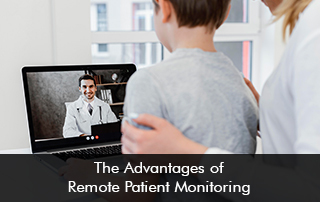The healthcare sector has adapted to new changes to provide remote care to patients due to the global pandemic. Adjusting to the new normal has not been easy for both providers and patients, but technology solutions made it easier to transition into bringing new care solutions. A May 2020 Capterra survey, revealed that 51% of the patients are not comfortable visiting the doctor’s office in COVID-19. Patients who have underlying conditions such as high blood pressure or have a chronic illness are considered at high risk for catching the virus. For such patients, remote patient monitoring (RPM) and Telemedicine EMR Software solutions have helped providers look after patients from the comfort of their homes and help manage their conditions remotely. Remote patient monitoring is in the spotlight making life simpler for both clinicians and healthcare providers. It only makes sense for practices to offer the powerful solutions of remote patient monitoring to its patients.
What is Remote Patient Monitoring (RPM)?
RPM is when clinicians monitor their patient’s health conditions remotely through the use of mobile devices and communications technologies. Wearable sensors used by the patients capture data related to blood pressure, heart rate, and weight, the medical device then transmits this data to the healthcare provider. This real-time data is important to keep providers informed about their patient’s health round the clock and foresee any misfortune. This has helped to enhance patient outcome levels.
Remote Patient Monitoring Market Growing
Remote patient monitoring has boomed in the last year due to advancements in cellular network connections, cloud computing, wearable technology, telemedicine, and remote patient monitoring technology. In 2020, the RPM market touched $23 billion and is expected to grow five times bigger by 2025. Hospitals and clinics in the US have been using RPM tools and devices to treat different patient conditions effectively.
3 benefits of offering Remote Patient Monitoring (RPM)
Infection risk is reduced
With the help of remote patient monitoring tools patients that have been tested positive for COVID-19 can be easily supervised remotely. Through sensors, thermometers critical data related to oxygen levels, and other changes can be monitored by the healthcare provider without any physical contact. The doctor can guide the patient throughout their treatment journey and prevent other people at your clinic from getting infected. Unnecessary trips to the hospital are eliminated for patients that have other chronic illnesses that need to be managed. Medical practices must expand the use of remote patient monitoring even after the pandemic is completely over.
New patients from the outskirts can be seen
Remote patient monitoring is especially helpful to attract patients that live in remote areas to stay connected with their healthcare providers. Patients in localities that are far from the city can manage different conditions like diabetes and heart conditions through RPM tools and sensors, the provider can get real-time data and monitor their health easily coupled with virtual care sessions. Patients who are physically challenged can also receive care effectively through remote patient monitoring technology. The ease and convenience of RPM have bought it mainstream in the healthcare industry, especially during the pandemic.
Higher revenues and productivity levels
Remote patient monitoring requires a big investment in medical devices and software technology however in the long run this investment will be fruitful. By avoiding over-crowding in your waiting room and seeing more patients in a day RPM can help to increase practice revenue and productivity.
The future of Remote Patient Monitoring
Many restrictions have been lifted and remote patient monitoring is now available to a greater group of Medicare patients. This suggests that your practice should start investing in RPM solutions for a brighter future. Keep a budget aside for this platform as more and more patients will expect your medical practice to offer the powerful facility of remote patient monitoring as it helps to provide better quality of care.







